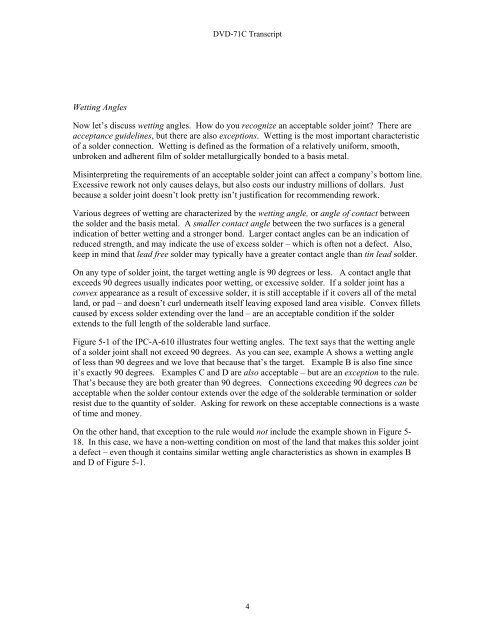DVD-71C IPC-A-610E Common Inspection Errors - IPC Training ...
DVD-71C IPC-A-610E Common Inspection Errors - IPC Training ...
DVD-71C IPC-A-610E Common Inspection Errors - IPC Training ...
- No tags were found...
You also want an ePaper? Increase the reach of your titles
YUMPU automatically turns print PDFs into web optimized ePapers that Google loves.
<strong>DVD</strong>-<strong>71C</strong> TranscriptWetting AnglesNow let’s discuss wetting angles. How do you recognize an acceptable solder joint? There areacceptance guidelines, but there are also exceptions. Wetting is the most important characteristicof a solder connection. Wetting is defined as the formation of a relatively uniform, smooth,unbroken and adherent film of solder metallurgically bonded to a basis metal.Misinterpreting the requirements of an acceptable solder joint can affect a company’s bottom line.Excessive rework not only causes delays, but also costs our industry millions of dollars. Justbecause a solder joint doesn’t look pretty isn’t justification for recommending rework.Various degrees of wetting are characterized by the wetting angle, or angle of contact betweenthe solder and the basis metal. A smaller contact angle between the two surfaces is a generalindication of better wetting and a stronger bond. Larger contact angles can be an indication ofreduced strength, and may indicate the use of excess solder – which is often not a defect. Also,keep in mind that lead free solder may typically have a greater contact angle than tin lead solder.On any type of solder joint, the target wetting angle is 90 degrees or less. A contact angle thatexceeds 90 degrees usually indicates poor wetting, or excessive solder. If a solder joint has aconvex appearance as a result of excessive solder, it is still acceptable if it covers all of the metalland, or pad – and doesn’t curl underneath itself leaving exposed land area visible. Convex filletscaused by excess solder extending over the land – are an acceptable condition if the solderextends to the full length of the solderable land surface.Figure 5-1 of the <strong>IPC</strong>-A-610 illustrates four wetting angles. The text says that the wetting angleof a solder joint shall not exceed 90 degrees. As you can see, example A shows a wetting angleof less than 90 degrees and we love that because that’s the target. Example B is also fine sinceit’s exactly 90 degrees. Examples C and D are also acceptable – but are an exception to the rule.That’s because they are both greater than 90 degrees. Connections exceeding 90 degrees can beacceptable when the solder contour extends over the edge of the solderable termination or solderresist due to the quantity of solder. Asking for rework on these acceptable connections is a wasteof time and money.On the other hand, that exception to the rule would not include the example shown in Figure 5-18. In this case, we have a non-wetting condition on most of the land that makes this solder jointa defect – even though it contains similar wetting angle characteristics as shown in examples Band D of Figure 5-1.4

















